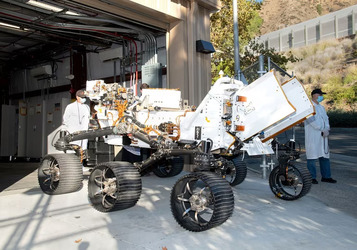The week's pick
Random Articles
Reseach Article
Navigation Signal Simulator for Performance Analysis of GNSS Signals
| Communications on Applied Electronics |
| Foundation of Computer Science (FCS), NY, USA |
| Volume 1 - Number 7 |
| Year of Publication: 2015 |
| Authors: Deepak Mishra, Sweta Bhardwaj, Alak Banik, T.v.s Ram, Parimal Majithiya |
 10.5120/cae-1600
10.5120/cae-1600
|
Deepak Mishra, Sweta Bhardwaj, Alak Banik, T.v.s Ram, Parimal Majithiya . Navigation Signal Simulator for Performance Analysis of GNSS Signals. Communications on Applied Electronics. 1, 7 ( May 2015), 24-30. DOI=10.5120/cae-1600
Abstract
Interoperability and compatibility is the main goal for current GNSS systems. A concept of Global Navigation Satellite System (GNSS) is to use all navigation system together to provide better capabilities compared with those that would be achieved relying solely on one service or signal. Compatibility, on the other hand, assures that existing GNSS signal is not degrading each other below certain threshold. GNSS provider is concerned about their own signal as well as other signals from different service provider for co-existence. For this reason interference analysis of current GNSS signal is the most needed requirement in current scenario. India is developing its own regional navigation systems named as Indian Regional Navigation Satellite System (IRNSS). An in-house tool is developed with suitable Graphic User Interface (GUI) which provides static analysis of different type of interference parameters and indicates its compatibility with already existing signals. Using the tool, this paper analyzes the degradation in IRNSS signal performance due to various navigation signals in different bands via consideration of parameters such as Power Spectral Density, Root Mean Square (RMS) Bandwidth and Rectangular Bandwidth. A detailed interference analysis of proposed signals is also calculated. In this paper, an attempt is made to analyze & review few suitable navigation signals for IRNSS in various navigation bands.
References
- RAN Yi-hang, LIU Yu-qi, HU Xiu-lin, KE Ting, "Evaluation of Intersystem Interference between Compass and Galileo", Journal of Convergence Information Technology, Volume6, Number 6, June 2011
- F. Soualle and T. Burger, Interference Analysis for the Global Navigation Satellites Systems Galileo and GPS, AstriumGalileo Phase B2 (post-KPM) document,GAL2-ASMD-TN-42154-002, 5. 05. 2002.
- S. Wallner, G. W. Hein, J. -A. Avila Rodriguez, T. Pany, A. Posfay,Interference Computations Between GPS and Galileo, Proceedings of the InternationalTechnical Meeting of the Institute of Navigation, ION-GNSS 2005, 13-16 September, 2005,Long Beach, California, USA.
- RAN Yi-hang, LIU Yu-qi, HU Xiu-lin, KE Ting, "Interference Analysis of Interplex Modulation in GALILEO E1 Band", Wireless Communications, Networking and Mobile Computing, 2009. WiCom '09. 5th International Conference , Page(s):1 - 4 ,E-ISBN :978-1-4244-3693-4,Print ISBN: 978-1-4244-3692-7, INSPEC Accession Number: 10952820 .
- Misra, P and Enge, P. , "Global Positioning System'', Ganga-Jamuna press, New York, 2011.
- John W Betz, "Binary Offset Carrier Modulations for Radio navigation", Journal of The Institute of Navigation, vol. 48, no. 4, winter 2001/2002.
- J. A. Avila-Rodriguez, "On generalized signal waveforms for satellite navigation'', PhD dissertation University FAF Munich, Neubiberg, Germany, pp. 408, June 2008.
- G. Hein et al, "The New optimized spreading modulation recommended for Galileo L1 OS and GPS L1 C'',Proceedings of the IEEE/ION Position, Location and Navigation Symposium, April 2006.
- B. W. Parkinson and J. J Spilker, "Global Positioning System: Theory and Applications", Vol. I, AIAA, 1996.
- Wei liu, "Assessing Radio Frequency Compatibility Between Galileo and Compass", Defence Science Journal, 2011.
- [GPS ICD 200, 2006] IS-GPS-200 Revision D, IRN-200D-001:NAVSTAR GLOBAL POSITIONING SYSTEM Navstar GPS Space Segment/Navigation User Interface, dated 7 March 2006.
- [GPS ICD-705, 2005] IS-GPS-705, IRN-705-003: Navstar GPS Space Segment/User Segment L5 Interfaces, 22 September 2005.
- GPS Interface Specification (ICD) , IRN-IS-200F-001: 21st Sept. 2011
- GLONASS Interface Control Document, version-5. 0, 2002
- GALILEO Signal-In-Space, ICD, May 2006
- QZSS Interface Specification (ICD), IS-QZSS, ver 1. 4, 28th Feb. 2012
- International Telecommunication Union Recommendation,ITU-RM,. 1831,"Acoordination methodology for RNSS inter-sytem interference estimation," 2007.
- J. W. Betz, Major David B. Goldstein, "Candidate Designs for an Additional Civil Signal in GPS Spectral Bands. "
- Maurizio Fantino, GianlucaMarucco, Paolo Mulassano, Marco Pini, "Performance Analysis of MBOC, AltBOC and BOC Modulations inTerms of Multipath Effects on the Carrier Tracking Loop within GNSS Receivers. "
- Elliott D. Kaplan, Christopher J. Hegarty, "Understanding GPSPrinciples and Applications, Second Edition".
- B. W. Parkinson and J. J. Spilker , "Global Positioning System:Theoryand Applications ," Vol. 1, AIAA, 1996.
- CDR document IRNSS, ISRO-SAC-IRNSS-CDR-01, JUNE 2102.
Index Terms
Keywords

